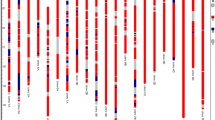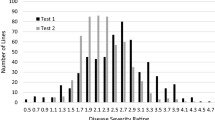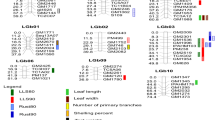Abstract
Verticillium wilt (VW, caused by Verticillium dahliae Kleb) is a destructive fungal soil-borne disease in Upland cotton (Gossypium hirsutum L.). High levels of VW resistance can be transferred into Upland from Pima cotton (G. barbadense L.) through interspecific introgression breeding. In this greenhouse study, VW resistance was evaluated in a multi-parent advanced generation inter-cross (MAGIC) introgressed line (IL) population, derived from a random mated Barbadense Upland population with five generations of intermating (called RMBUP-C4) between three Upland cotton cultivars and 18 CS-B Upland lines each carrying a pair of G. barbadense chromosome or arm in the TM-1 background. The objectives of this study were to, (1) evaluate VW resistance of 530 MAGIC ILs in the greenhouse; and (2) to identify lines with VW resistance in the MAGIC population based on a total of three replicated greenhouse tests. Approximately 8 plants for each line in each replicate were grown and screened for VW resistance using three parameters i.e., disease leaf severity rating, percentage defoliated leaves, and percentage infected plants, with a total of ~ 25,190 plants evaluated. A correlation analysis indicated that the three parameters were significantly and positively correlated with one another in each test. The disease leaf severity rating was the best parameter to assess VW resistance due to its relatively low coefficient of variation and its higher resolution to differentiate resistant genotypes from susceptible ones. Of the 530 genotypes, 5 showed resistance to VW, namely, NMIL348, NMIL518, NMIL405, NMIL290, NMIL307 and had higher levels of resistance to VW with mean disease leaf severity ratings, percentage of defoliated leaves, and percentage of infected plants across three tests ranging from 0.58–1.46, 9.46–26.74, and 25–95%, respectively. These lines can be used as parental lines to improve VW resistance in cotton breeding programs.
Similar content being viewed by others
References
Anamthawat-Jónsson K (2001) Molecular cytogenetics of introgressive hybridization in plants. Methods Cell Sci 23(1–3):139–148
Bolek Y, El-Zik KM, Pepper AE, Bell AA, Magill CW, Thaxton PM, Reddy OUK (2005) Mapping of Verticillium wilt resistance genes in cotton. Plant Sci 168:1581–1590
Carpenter CW (1914) The Verticillium wilt problem. Phytopathology 4:393
Fang H, Zhou H, Sanogo S, Flynn R, Percy RG, Hughs SE (2013) Quantitative trait locus mapping for Verticillium wilt resistance in a backcross inbred line population of cotton (Gossypium hirsutum × Gossypium barbadense) based on RGA-AFLP analysis. Euphytica 194:79–91
Friebertshauser G, DeVay J (1982) Differential effects of the defoliating and nondefoliating pathotypes of Verticillium dahliae upon the growth and development of Gossypium hirsutum. Phytopathology 72:872–877
Huang EB, Verbyla KL, Verbyla A, Raghavan C, Singh V, Guar P, Cavanagh CR (2015) MAGIC populations in crops: current status and future prospects. Theor Appl Genet 128:999–1017
Jenkins JN, McCarty JC, Gutierrez OA, Hayes RW, Jones DC (2013) Registration of RMBUP-C4, a random-mated population with Gossypium barbadense L. alleles introgressed into Upland cotton germplasm. J Plant Regist 7:224–228
Klosterman SJ, Atallah ZK, Vallad GE, Subbarao KV (2009) Diversity, pathogenicity, and management of Verticillium species. Annu Rev Phytopathol 47:39–62
Liu RJ (1995) Effect of vesicular-arbuscular mycorrhizal fungi on Verticillium wilt of cotton. Mycorrhiza 4:293–297
Nannipieri P, Grego S, Ceccanti B (1990) Ecological significance of the biological activity in soil. Soil Biochem 6:293–355
Oakley S (1998) Breeding for resistance to Verticillium wilt and root-knot nematode in California Acalas. In: Proceedings of the Beltwide Cotton Conferences, p 128
Pegg GF, Brady BL (2002) Verticillium wilts. CAB International, Wallingford, p 37
Pullman GS, DeVay JE, Garber RH, Weinhold AR (1981) Soil solarization: effects on Verticillium wilt of cotton and soilborne populations of Verticillium dahliae, Pythium spp., Rhizoctonia solani, and Thielaviopsis basicola. Phytopathology 9:954–959
Shapovalov M, Rudolph BA (1930) Verticillium hadromycosis (wilt) of Cotton in California. Plant Dis Rep 14:2
Stelly DM, Saha S, Raska DA, Jenkins JN, McCarty JC, Gutierrez OA (2005) Registration of 17 Upland (Gossypium hirsutum) cotton germplasm lines disomic for different G. barbadense chromosome or arm substitutions. Crop Sci 45:2663–2665
USDA-ERS (2017a) Cotton and Wool Outlook: August 2017. https://www.ers.usda.gov/publications/pub-details/?pubid=84691. Accessed on 25 July 2018
USDA-ERS (2017b) Cotton and Wool Outlook. http://usda.mannlib.cornell.edu/usda/ers/CWS//2010s/2017/CWS-09-14-2017.pdf. Accessed 25 July 2018
USDA-ERS (2018) Cotton Outlook. https://www.usda.gov/oce/forum/2018/commodities/Cotton.pdf. Accessed on 25 July 2018
USDA-NASS (2018) World Agricultural Production. https://www.nass.usda.gov/Statistics_by_Subject/result.php?B9D5B9F1-2AEC-3A16-B831-36725976844A§or=CROPS&group=FIELD%20CROPS&comm=COTTON. Accessed on 25 July 2018
Wheeler TA, Woodward JE (2016) Field assessment of commercial cotton cultivars for Verticillium wilt resistance and yield. Crop Prot 88:1–6
Wheeler TA, Bordovsky JP, Keeling JW, Mullinix BG Jr (2012) Effects of crop rotation, cultivar, and irrigation and nitrogen rate on Verticillium wilt in cotton. Plant Dis 7:985–989
Wilhelm S, Ferguson J (1953) Soil fumigation against Verticillium albo-atrum. Phytopathology 43:593–596
Wilhelm S, Sagen JE, Tietz H (1974) Resistance to Verticillium wilt in cotton: sources, techniques of identification, inheritance trends, and the resistance potential of multiline cultivars. Phytopathology 64:924–931
Xiao CL, Subbarao KV, Schulbach KF, Koike ST (1998) Effects of crop rotation and irrigation on Verticillium dahliae microsclerotia in soil and wilt in cauliflower. Phytopathology 10:1046–1055
Zhang J, Lu Y, Adragna H, Hughs E (2005) Genetic improvement of New Mexico Acala cotton germplasm and their genetic diversity. Crop Sci 45:2363–2373
Zhang J, Sanogo S, Flynn R, Baral JB, Bajaj S, Percy RG (2012) Germplasm evaluation and transfer of Verticillium wilt resistance from Pima (G. barbadense) to Upland cotton (G. hirsutum). Euphytica 187:147–160
Zhang J, Percy RG, McCarthy JC (2014a) Introgression genetics and breeding between Upland and Pima cotton: a review. Euphytica 198:1–12
Zhang J, Fang H, Zhou H, Sanogo S, Ma Z (2014b) Genetics, breeding, and marker-assisted selection for Verticillium wilt resistance in cotton. Crop Sci 4:1289–1303
Zhou H, Fang H, Sanogo S, Hughs S, Jones D, Zhang J (2014) Evaluation of Verticillium wilt resistance in commercial cultivars and advanced breeding lines of cotton. Euphytica 196:437–448
Author information
Authors and Affiliations
Corresponding author
Rights and permissions
About this article
Cite this article
Martinez, G., Abdelraheem, A., Darapuneni, M. et al. Evaluation of a multi-parent advanced generation inter-cross (MAGIC) introgressed line population for Verticillium wilt resistance in Upland cotton. Euphytica 214, 197 (2018). https://doi.org/10.1007/s10681-018-2278-0
Received:
Accepted:
Published:
DOI: https://doi.org/10.1007/s10681-018-2278-0




